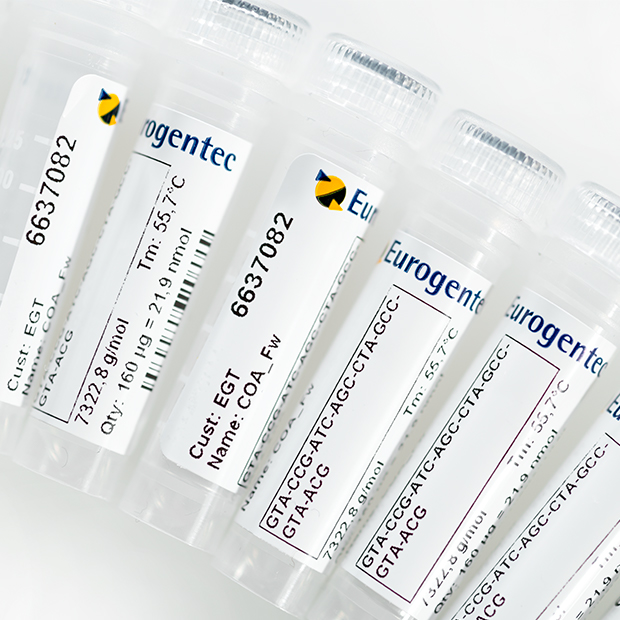We use cookies to offer you the best experience on our site. You can find out more about the cookies we use or disable them in the Cookie settings
Gene regulation by RNA interference
siRNA Duplexes
We provide custom synthesis of siRNA oligonucleotides at small and large scales and can assist you for the design of your sequences for free. In addition, we also deliver ready-to-use negative and positive siRNA controls in order to monitor your siRNA experiment conditions.
Custom siRNA synthesis
The most widely used siRNA are 21-mer. They are usually composed of 19 double stranded RNA bases and 2 single stranded DNA bases (usually two Thymidine) in 3’end. We offer multiple options available to synthesize the siRNA molecule that fits at best your need.
The standard specifications displayed here can be adapted according to your application. If you need assistance, we offer free siRNA design with a silencing guarantee.
siRNA Specifications
Length
siRNA sequence length is comprised between 21 and 27 bases
Synthesis scale
We manufacture siRNA in small and large quantities.
- SePOP purified siRNA are delivered in 7, 22, 60 or 200 nmol
- HPLC and in vivo purified oligos are delivered in 3, 12, 40 or 80 nmol
Larger scales are available on request.
Backbones
siRNA sequences can be built with RNA, LNA®, 2’O-Me RNA
or 2'O-MOE RNA bases.
Phosphorothioate linkages can be added to increase
nuclease resistance.
Modifications
We can modify your siRNA sequence with various molecules :
- 5’ modifications : Phosphate, 6-FAM, AlexaFluor®, ATTO, Biotin, Cy®3,
Cy5®, Fluorescein, HEX,... - 3’ modifications : 6-FAM, Cy®3, Cy5®, Rhodamine, TEG-Cholesteryl, TAMRA...
Purifications
siRNA oligonucleotides can be purified by IEX-HPLC or RP-HPLC
or follow our SePOP Desalting or in vivo process
Quality Control
We control every production of custom siRNA oligonucleotides
by MALDI-TOF MS
Delivery
We deliver custom siRNA sequence dried at room temperature in 2 mL tube
A purity adapted to your application
We manufacture and deliver your siRNA oligonucleotides to reach the purity level your application requires.
| SePOP Desalted | IEX/RP-HPLC | In Vivo* | |
|---|---|---|---|
| Desalting by precipitation | • | • | • |
| MALDI-TOF QC | • | • | • |
| IEX/RP HPLC | • | • (IEX only) | |
| Duplexed | • | • | • |
| Desalting by size exclusion chromatography | • | ||
| Sterile filtration | • | ||
| Lyophilisation | • |
Comparison between the SePOP and HPLC purifications and the in vivo process method for a siRNA duplex
*Production process endotoxin tested
The interest of siRNA duplexes
RNA oligonucleotides are mainly used to study the involvement of RNA in gene regulation. Synthetic siRNA duplexes are introduced into cells to cause RNA interference and inhibit the expression of a specific messenger RNA (mRNA).
Figure 1 :
Principle of siRNA-mediated RNA interference. The annealed siRNA enters the cell (1). Once inside, double stranded RNA is recognized by the RISC complex. Sense strand siRNA is displaced and the mRNA anneal to the antisense siRNA fixed to the RISC complex (2). mRNA is digested (3) and the RISC complex containing the siRNA is then recycled to begin a new cycle (4).


